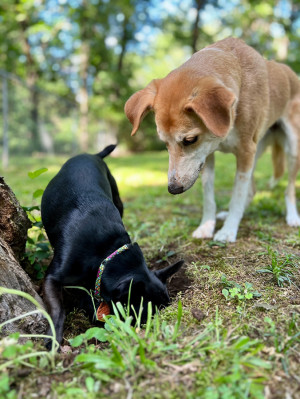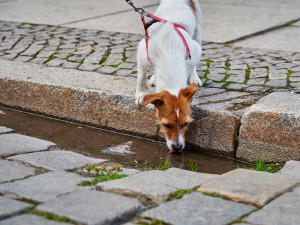Mange in Dogs: Causes, Symptoms, and Treatment For Canine Skin Condition
Cool, cool, cool (heavy sarcasm here). These are some steps you can take.

share article
OK, don’t freak out, but here are a couple of questions: Has your puppy’s coat started to thin around the eyes? Does your older dog’s skin suddenly look a little like Deadpool’s? A dog can develop skin issues for many reasons, but mange is one of the most common. Although most people have heard the term “mangy” to describe a shabby-looking coat (maybe just in the movie Annie, but still), many don’t relate it to an actual disease.
What is mange?
Mange is a skin disease triggered by microscopic, parasitic mites. Mange can either be localized or generalized. Localized mange occurs primarily on the face, especially around the eyes. It can show up in other areas as well and still be considered localized, as long as it is limited to a couple of spots in one area. Generalized mange either encompasses larger patches, involves multiple areas of the body, persists for more than six months, or affects the feet.
What causes mange?
Mange in dogs is caused by an overgrowth of parasitic mites. These mites can overcome the skin’s natural defenses if a dog’s immune system is compromised due to genetics, drugs, or disease. Once the normal skin barriers are broken, mange mite infestation can lead to secondary bacterial infection as well.
Types of mange in dogs
There are two primary types of mange in dogs: demodectic and sarcoptic. There are important differences between the types of mange that affect treatment, prognosis, and spread.
Demodectic mange is caused by the Demodex mite. These mites live in a dog’s hair follicles and are normally passed from mother to pup early in life. They are an expected resident of a dog’s skin but usually occur in small numbers. When a dog’s immune system isn’t working like it should, these mites can grow rapidly in number and begin to cause issues.
Demodectic mange comes in two varieties: juvenile-onset and adult-onset. Juvenile-onset mange is usually localized and mild, though some dogs are unlucky and develop generalized mange. This generalized version occurs more commonly in American Staffordshire Terriers, other Pit Bull-type dogs, English and French Bulldogs, Chinese Shar Pei, and Boxers. Adult-onset mange is usually associated with something suppressing the immune system, like hypothyroidismopens in a new tab, Cushing’s diseaseopens in a new tab, diabetesopens in a new tab, steroid administration, or chemotherapy.
Sarcoptic mange (also called scabies) is caused by a Sarcoptes scabiei mite that is specific to dogs. These mites are not a normal part of a dog’s skin population. They usually live on the surface of the skin, but female mites will tunnel into the skin to lay eggs. Even a few of these mites will cause severe irritation because dogs react strongly to the mite’s outer shell, eggs, and feces.
Can mange be transmitted from dogs to humans or other pets?
Demodectic mange is generally considered not to be contagious, because they’re a normal resident of a dog’s skin. Sarcoptic mange is very contagiousopens in a new tab to other dogs, humans, and pets. If everyone in the house, including the dog, has itchy spots, it’s probably time to see both your veterinarian and your own primary care doctor.
What are the early signs of mange In dogs?
Mange can show up in a few different ways, depending on the type of mite and the dog’s immune system. Most mild cases of juvenile-onset demodectic mange involve a couple of small, thin-haired spots with a crusty appearance to the skin around the eyes, on the face, or on the legs. Generalized demodectic mange lesions may be larger and more severe.
Sarcoptic mange tends to show up along the margins of the ears, on the elbows, on the lower chest, and on the outside of a dog’s ankles. General sign of mange can include:
Hair loss
Skin lesions (crusts, scales, pimples)
Redness
Swelling
Discharge from the ears
Itching (more common in sarcoptic mange)
Hyperpigmentation (darkening of the skin)
How is mange treated?
Mange is treated very differently than most other skin diseasesopens in a new tab in dogs. The type of mange will help to determine the treatment. Many puppies with a mild case of mange may not need any treatment at all. Because most localized bouts of juvenile demodicosis resolve quickly on their own, treatment isn’t necessary for most puppies. Dogs with generalized demodectic mange or sarcoptic mange will need treatment though.
Medications for mange
Mange was originally treated with a chemical dip that smelled terrible, needed to be done weekly, and had some possibly nasty side effects. Fortunately, it can now be treated with oral flea or heartworm preventatives. The most common medications used today are the same oral flea products your dog may already be on: Nexgard®, Bravecto®, Simparica®, and Credelio®. These products are used with caution in dogs with a history of seizuresopens in a new tab.
If those medications are not appropriate for your dog or are not able to resolve the issue, certain medications used to treat heartworms may be used. These drugs must be given at a much higher dose than usual for this and can be dangerous for dogs with certain genetic mutations. Your veterinarian can determine the best drug and plan for your dog based on their history and the severity of their mange.
Home remedies for mange
This may sound a little weird, but please, please, please do not put motor oil on your dog for mange. Don’t do it even if you read a very convincing website. Don’t do it even if your neighbor said it worked great for their dog back in the ‘70s. Don’t do it if you care about your dog. Motor oil is bad for dogs and is not a treatment for mange. There are no effective home remedies for mange. Take your dog to your vet to get safe and effective treatment.
How do you prevent your dog from getting mange?
Because Demodex is a normal part of your dog’s skin, getting rid of it completely isn’t practical. The best plan for long-term prevention is to remove dogs with generalized juvenile demodicosis from the breeding pool. For adult dogs, the best preventative is regular veterinary care, which can catch any conditions affecting their immune system early on.
The best way to prevent sarcoptic mange is to avoid exposure to dogs or other animals with the disease. Don’t let your dog interact with dogs with unknown skin lesions and keep them away from wildlife (foxes are a major carrier of Sarcoptes).
How long does it take for a dog with mange to recover?
Once treatment is initiated, most dogs with mange recover within a month or two. Immunocompromised dogs may take longer to bounce back because the condition affecting their immune system needs to be stabilized before mite treatment can be effective.
Overall, mange carries a good prognosis for recovery with appropriate treatment. While severely affected dogs can look gross and miserable, they can get back to sporting a lustrous coat in a relatively short time.
FAQ
1) What are the early signs of mange in dogs?
Thinning of hair, crusty skin lesions, and redness of skin are some common early signs of mange.
2) How do you treat mange?
Seeing your veterinarian for oral or topical medication is the best way to give your dog relief quickly.
3) Can I treat mange in my dog at home?
Mange in dogs cannot be treated with home remedies. The most commonly mentioned home remedies can be dangerous for dogs.
4) How long does it take for a dog with mange to recover?
Modern therapies for mange treat mites in as little as one or two doses, and dogs often recover within a month or two.
5) Can mange be transmitted from dogs to humans or other pets?
Sarcoptic mange can be transmitted to other dogs, humans, or other pets. Demodectic mange is not considered contagious.
6) How do I prevent my dog from getting mange?
Avoid exposing your dog to animals with known sarcoptic mange or unknown skin lesions. Follow your vet’s recommendations to watch for diseases causing immunosuppression.

Dr. Bartley Harrison, DVM
Dr. Bartley Harrison, DVM is a small animal veterinarian based in North Carolina who has practiced emergency medicine since graduating from the Texas A&M College of Veterinary Medicine. His primary interest areas include pain management, cardiology, and the treatment of shock.
He is a member of the Veterinary Emergency and Critical Care Society, American Veterinary Medical Association, and American Medical Writers Association. In addition to his clinical work, he writes pet health articles to help provide accurate information for both new and experienced pet parents. When he’s not working, he enjoys cooking, traveling, reading, and going on adventures with his dog.
Related articles
![Black puppy itches behind her ear due to flea allergy]() opens in a new tab
opens in a new tabShoo, Flea: What to Do About Your Dog’s Disturbing Flea Allergy
Before you say “ewww” Moira Rose-style, learn these steps to prevent and remove fleas.
![Woman holding a beagle in warm dappled summer light]() opens in a new tab
opens in a new tabYou’ve Got a Summer-Lovin’ Pup. Here’s How to Keep Them Safe
Some like it hot (but not most dogs). Here are the season’s health hazards, from fleas to foxtails.
![Dog drinking water from a puddle in the road]() opens in a new tab
opens in a new tabGiardia in Dogs: Signs, Symptoms and Treatment of This Parasite
If your dog drinks from puddles or splashes around in lakes, read this.
![Mixed-breed puppy licks its paw in the grass]() opens in a new tab
opens in a new tabHow to Spot, Treat, and Prevent Hot Spots on Your Dog
Unfortunately, this term refers to a “summer sore,” not a club coveted by SNL’s Stefon.
![Cute weimaraner dog lying on lawn and scratching its back]() opens in a new tab
opens in a new tab5 of the Best Ways to Solve Your Dog’s Allergies
Here’s what works (and what doesn’t).










